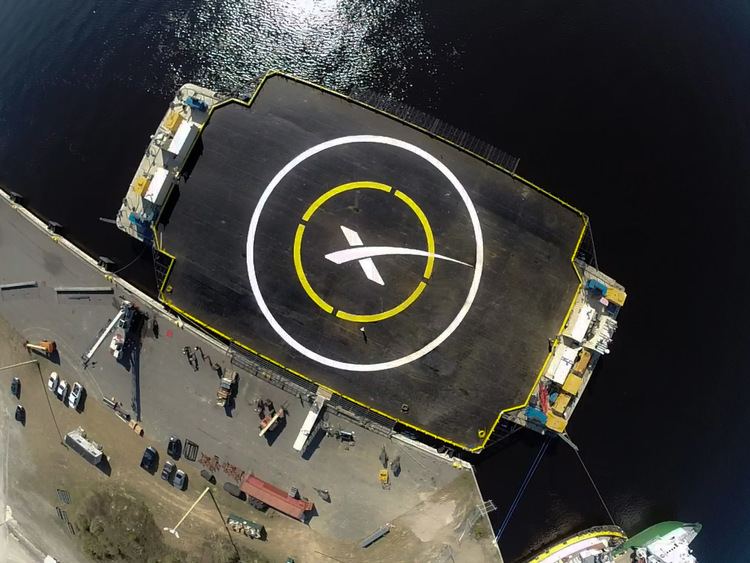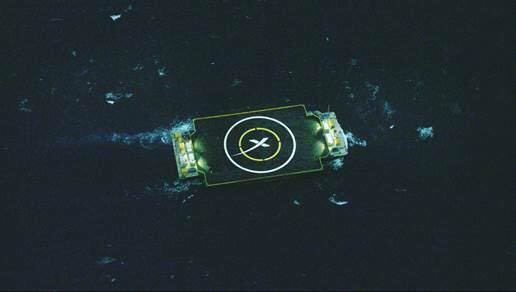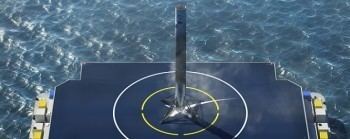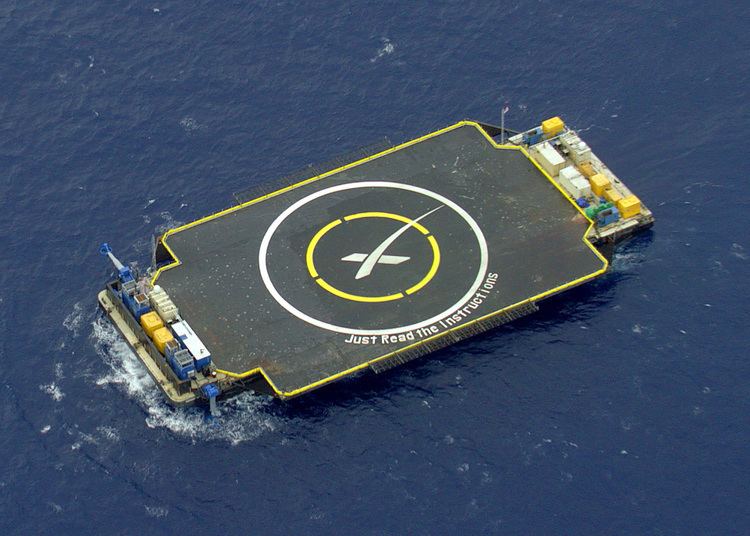Short name ASDS Status Active Beam 52 m | Length 88 m Owner SpaceX | |
Launch pad(s) 2 oceangoing landing platforms | ||
Spacex autonomous spaceport drone ship just read the instructions video 5 barge damage
An autonomous spaceport drone ship (ASDS) is an ocean-going vessel derived from a deck barge, outfitted with station-keeping engines and a large landing platform. Construction of such ships was commissioned by aerospace company SpaceX to allow for recovery of rocket first-stages at sea for high-velocity missions which do not carry enough fuel to return to the launch site after lofting spacecraft onto an orbital trajectory.
Contents
- Spacex autonomous spaceport drone ship just read the instructions video 5 barge damage
- Spacex s falcon 9 rocket crash landing on autonomous spaceport drone ship
- History
- Upgrading the ASDS fleet
- Of Course I Still Love You
- Marmac 303
- Characteristics
- Naming
- Just Read the Instructions Marmac 300
- Of Course I Still Love You Marmac 304
- Just Read the Instructions Marmac 303
- Operation
- Vessel missions
- January 2015 landing attempt
- February 2015 tow
- April 2015 landing attempt
- June 2015 tow
- January 2016 Marmac 303 Pacific coast
- 4 March 2016
- 8 April 2016
- 6 May 2016
- 27 May 2016
- 15 June 2016
- 14 August 2016
- 14 January 2017
- References

SpaceX has two operational drone ships, the Just Read the Instructions in the Pacific Ocean for launches from Vandenberg and the Of Course I Still Love You in the Atlantic for launches from Cape Canaveral. As of January 2017, ten Falcon 9 flights have attempted to land on a drone ship, with five of them succeeding: the first successful attempt being the CRS-8 mission in April 2016.

The ASDS ships are a key component of the SpaceX reusable launch system development program which aims to significantly lower the price of space launch services through "full and rapid reusability." Any flights going to geostationary orbit or exceeding escape velocity will require landing at sea, encompassing about half of SpaceX missions.

Spacex s falcon 9 rocket crash landing on autonomous spaceport drone ship
History

In 2009 SpaceX CEO Elon Musk articulated ambitions for "creating a paradigm shift in the traditional approach for reusing rocket hardware."

In October 2014 SpaceX publicly announced that they had contracted with a Louisiana shipyard to build a floating landing platform for reusable orbital launch vehicles. Early information indicated that the platform would carry an approximately 90-by-50-meter (300 ft × 160 ft) landing pad and would be capable of precision positioning so that the platform could hold its position for launch vehicle landing. On 22 November 2014 Musk released a photograph of the "autonomous spaceport drone ship" along with additional details of its construction and size.

As of mid-December 2014, the ship, the McDonough Marine Service's Marmac 300 deck barge, was based in Jacksonville, Florida, at the northern tip of the Jacksonville Port Authority's JAXPORT Cruise Terminal (30.409144°N 81.582493°W / 30.409144; -81.582493) where SpaceX have built a stand to secure the Falcon stage during post-landing operations. The stand consists of four 15,000 lb (6,800 kg), 107 in (270 cm) tall and 96.25 in (244.5 cm) wide pedestal structures bolted to a concrete base. A mobile crane will lift the stage from the ship and place it on the stand. Tasks such as removing or folding back the landing legs prior to placing the stage in a horizontal position for trucking will occur here.
The ASDS landing location for the first landing test was in the Atlantic Ocean approximately 200 miles (320 km) northeast of the launch location at Cape Canaveral, and 165 miles (266 km) southeast of Charleston, South Carolina.
On 23 January 2015, during repairs to the ship following the unsuccessful first test, Musk announced that the ship was to be named Just Read the Instructions, with a sister ship planned for West Coast launches to be named Of Course I Still Love You. On 29 January, SpaceX released a manipulated photo of the ship with the name illustrating how it would look once painted. Both ships are named after two GCUs (General Contact Units), spaceships commanded by autonomous artificial intelligences, that appear in The Player of Games, a Culture novel by Iain M. Banks.
The deck barge was modified once again in May 2015, removing the wings that had extended the barge surface and the equipment (thrusters, communications gear, etc.) that had been added to refit it as an ASDS.
Upgrading the ASDS fleet
SpaceX subsequently leased two additional deck barges—Marmac 303 and Marmac 304—and initiated refit to construct two additional autonomous-operation-capable ASDS ships, built on the hulls of much-newer barges.
Of Course I Still Love You
A new ASDS barge, Of Course I Still Love You (OCISLY), had been under construction in a Louisiana shipyard since early 2015. It was built as a replacement of the barge Marmac 300 and entered operational service for Falcon 9 Flight 19 in late June 2015. As of June 2015, its home port was Jacksonville, Florida, but after December 2015, it was home ported 160 miles (260 km) further south, at Port Canaveral.
Of Course I Still Love You was constructed on a different, and much newer, hull—Marmac 304—in order to service launches on the East Coast of the United States. While the dimensions of the ship are nearly identical to the original ASDS ship, several enhancements were made including a steel blast wall erected between the aft containers and the landing deck. The ship was in place for a first-stage landing test on the CRS-7 mission, which failed on launch on 28 June 2015.
After approximately six months of service Just Read the Instructions was retired from ASDS operations in the Atlantic, and its duties were assumed by Of Course I Still Love You.
On 8 April 2016 the first-stage, which launched the Dragon CRS-8 spacecraft, successfully landed on Of Course I Still Love You.
Marmac 303
A third ASDS barge was built during 2015.
Initial refit of Marmac 303 was completed in a Louisiana shipyard, and the barge transited the Panama Canal in June 2015 carrying its wing extensions as cargo on the deck because the ASDS, when complete, would be much too wide to pass via the canal.
The home port for Marmac 303 is the Port of Los Angeles, at the AltaSea marine research and business campus in San Pedro's outer harbor. The landing platform and tender vessels began docking there in July 2015 in advance of the main construction of AltaSea which is scheduled for 2017.
SpaceX announced that the new-hull Marmac 303 would be named Just Read the Instructions until January 2016, shortly before its first use as a landing platform for Falcon 9 Flight 21.
On 17 January 2016, Just Read the Instructions was put to first use in an attempt to recover a Falcon 9 first-stage booster from the Jason-3 mission from Vandenberg. The booster successfully landed on the deck however a lockout collet failed to engage on one of the legs causing the rocket to tip over, exploding on impact with the deck.
Characteristics
ASDSes are autonomous vessels capable of precision positioning, originally stated to be within 3 meters (9.8 ft) even under storm conditions, using GPS position information and four diesel-powered azimuth thrusters. In addition to the autonomous operating mode, the ships may also be telerobotically controlled.
The azimuth thrusters are hydraulic propulsion outdrive units with modular diesel-hydraulic-drive power units and a modular controller all manufactured by Thrustmaster, a marine equipment manufacturer. The returning rocket must not only land within the confines of the deck surface but must also deal with ocean swells and GPS errors.
SpaceX equips the ships with a variety of sensor and measurement technology to gather data on the booster returns and landing attempts, including commercial off the shelf GoPro cameras.
At the center of the ASDS landing pads is a circle that encloses the SpaceX stylized "X" in an X-marks-the-spot landing point.
Naming
The two ASDS names used so far, Just Read the Instructions (JRtI), and Of Course I Still Love You (OCISLY), pay homage to the works of the late science fiction author Iain M. Banks, and are drawn from his Culture fictional universe. Both JRtI and OCISLY are names of enormous, sentient starships, which appeared in the novel The Player of Games.
Just Read the Instructions (Marmac 300)
The landing platform of the upper deck of the initial Just Read the Instructions (JRtI) vessel was 52 m × 91 m (170 ft × 300 ft) while the span of the Falcon 9 v1.1 landing legs was 18 m (60 ft).
Of Course I Still Love You (Marmac 304)
Of Course I Still Love You was built as a refit of deck barge Marmac 304. It is home ported in Florida at Port Canaveral since December 2015, after being ported for a year at the Port of Jacksonville during most of 2015.
Just Read the Instructions (Marmac 303)
Just Read the Instructions was built as a refit of deck barge Marmac 303 in 2015 for service in the Pacific Ocean. It is home ported at the Port of Los Angeles in southern California.
Operation
During rocket landing operations, a separate support ship is typically standing by some distance away from the crewless drone ship. Following landing, technicians and engineers will reboard the landing platform, and secure the rocket's landing legs to lock the vehicle in place for transport back to port. The rocket stage is secured to the deck of the drone ship with steel hold downs welded on to the feet of the landing legs.
Vessel missions
One of the series of autonomous ships has been used for four flight tests, three in early 2015 (although only two actually attempted landings on an ASDS) plus one more in January 2016.
The first test was 10 January 2015 when SpaceX conducted a controlled-descent flight test to land the first-stage of Falcon 9 Flight 14 on a solid surface after it was used to loft a contracted payload toward Earth orbit. SpaceX projected prior to the first landing attempt that the likelihood of successfully landing on the platform would be 50 percent or less.
January 2015 landing attempt
SpaceX attempted a landing on Just Read the Instructions on 10 January 2015. Many of the test objectives were achieved, including precision control of the rocket's descent to land on the platform at a specific point in the south Atlantic Ocean and a large amount of test data was obtained from the first use of grid fin control surfaces used for more precise reentry positioning. However the landing was a hard landing.
The SpaceX webcast indicated that the boostback burn and reentry burns for the descending first-stage occurred, and that the descending rocket then went "below the horizon," as expected, which eliminated the live telemetry signal. Shortly thereafter, SpaceX released information that the rocket did get to the drone spaceport ship as planned, but "landed hard ... Ship itself is fine. Some of the support equipment on the deck will need to be replaced."
A video of the landing was posted to Vine.
February 2015 tow
Just Read the Instructions was towed to sea once again in early February for the DSCOVR satellite launch on 11 February 2015 but, in the event, was not used for a landing attempt. Ocean conditions of 7 m (23 ft)-high waves interfered with the ASDS recovery duties for the landing, so the ship returned to port and no landing test occurred and SpaceX executed a soft landing in the sea to continue data gathering for future landing attempts. The soft landing was successful, Elon Musk tweeted that it landed with a lateral accuracy of 10 m (33 ft) away from the target and in a vertical position.
April 2015 landing attempt
On 14 April 2015, SpaceX made a second and final attempt to land a Falcon first-stage on the Marmac 300 drone ship. Early news from Elon Musk suggested that it made a hard landing on the drone ship. He later clarified that it appeared to have made a vertical landing on the ship, but then toppled over due to excessive remaining lateral momentum.
June 2015 tow
In order to prepare for Falcon 9 Flight 19 on 28 June 2015, the new ASDS, Of Course I Still Love You, was towed out to sea to prepare for a third landing test. This was its first operational assignment. However, the Falcon launch rocket disintegrated before first-stage shutdown so the mission never progressed to the point where the controlled-descent test was to be initiated.
January 2016: Marmac 303, Pacific coast
SpaceX indicated on 7 January that there would be an attempt to land on the new west coast ASDS following the launch of Falcon 9 Flight 21 scheduled for 17 January 2016.
Just Read the Instructions, was located about 200 miles (320 km) downrange from the launch site in the Pacific Ocean. Elon Musk later reported that the first-stage did successfully soft-land on the ship, but a lockout latch on one of the landing legs failed to latch and the first-stage fell over, causing a breach of the propellant tanks and a deflagration on impact with the drone ship.
4 March 2016
During a launch of a heavy communications satellite on 4 March 2016, SpaceX did an experimental descent and landing attempt with very low propellant margins. For the first time, and in order to reduce the propellant required, SpaceX attempted the landing burn with three engines. SpaceX had indicated that the test was unlikely to result in a successful landing and recovery. In the event, one engine flamed out early, and the rocket hit the deck surface with considerable velocity, destroying the rocket and causing damage to Of Course I Still Love You . By March 21, 2016, the deck of the drone ship was nearly repaired.
8 April 2016
The Falcon 9 first-stage performed a successful landing on Of Course I Still Love You in the Atlantic Ocean off the coast of Florida at T+9 minutes and 10 seconds after liftoff, the first-ever successful landing of the first-stage on an Autonomous Spaceport Drone Ship. The rocket was successfully affixed to the barge for the maritime transport portion of the journey back to port, and successfully completed its journey, entering Port Canaveral early in the morning on 12 April 2016.
6 May 2016
On May 6, 2016, SpaceX landed the first-stage of the Falcon 9 on Of Course I Still Love You during the JCSat-14 mission, its second time successfully landing on a drone ship at sea, and its first time recovering a booster from a high-velocity (GTO) mission.
27 May 2016
On May 27, 2016, SpaceX landed the first-stage of a Falcon 9 on Of Course I Still Love You during the Thaicom 8 mission, its third time successfully landing on a drone ship at sea.
15 June 2016
On June 15, 2016, SpaceX failed to land the first-stage of the Falcon 9 on Of Course I Still Love You during the Asia Broadcast Satellite/Eutelsat mission. Elon Musk tweeted that one of the three engines had low thrust, and when the rocket was just off the deck, the engines ran out of oxidizer.
14 August 2016
SpaceX's Falcon 9 Flight 28 propelled the Japanese JCSAT-16 telecommunications satellite to a geosynchronous transfer orbit on August 14, 2016. The first stage re-entered the atmosphere and during the night landed vertically on Of Course I Still Love You, positioned in the Atlantic Ocean nearly 400 miles from the Florida coastline; unlike previous successful landings, this landing-burn only used one engine, not three.
14 January 2017
On January 14, 2017, the first-stage of a Falcon 9 landed on the Pacific ASDS Just Read the Instructions during the Iridium NEXT-1 mission. This marked the first successful landing on the Just Read the Instructions drone ship and the first landing in the Pacific Ocean.
